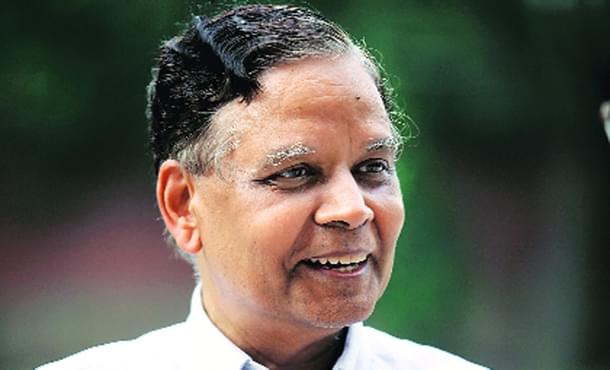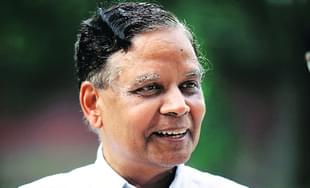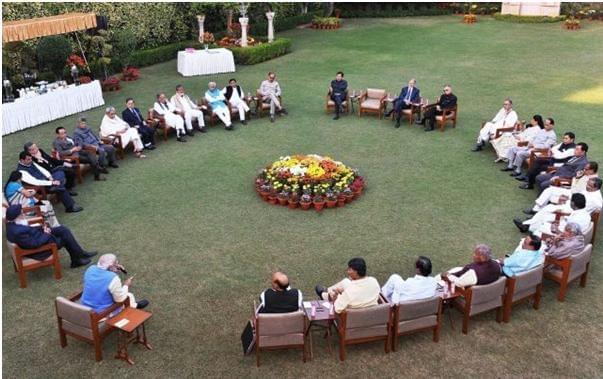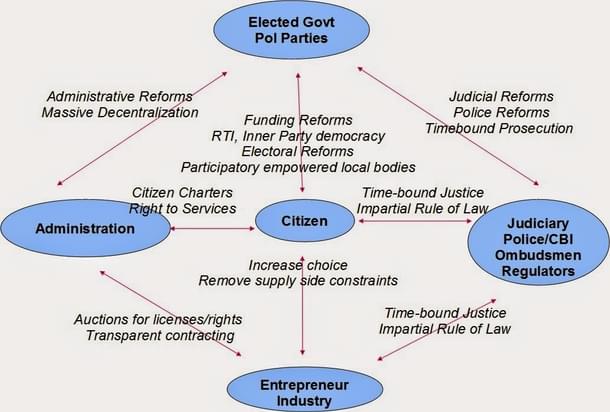Economy
Can Niti Aayog Place the Citizen at the Heart of Governance?
Ram Ramdas
Jan 21, 2015, 11:30 AM | Updated Feb 18, 2016, 12:13 PM IST
Save & read from anywhere!
Bookmark stories for easy access on any device or the Swarajya app.


NITI Aayog should be mandated to make Sabka Vikas, a surety, not just a probability. This requires the citizen to be brought back to the heart of our governance model.
For a citizen like me, born in the Indira era of Bank nationalisation, Emergency and Garibi Hatao Politics –an era when allotment letters of Bajaj Scooters (the scooters to be delivered seven to ten years later!), was considered a “precious dowry for a daughter’s marriage, and getting that occasional extra half liter milk packet in the morning was a life achievement in itself – January 1, 2015 when NITI Aayog was announced, was a watershed in the journey of our nation.

William Gladstone, one of the greatest PMs and liberal democrats, that the United Kingdom has had, said:
“Liberalism is trust of the people tempered by prudence. Conservatism is distrust of the people tempered by fear.”
For 67 excruciatingly painful long years, India has been governed with the spirit of conservatism. The consequent Hindu rate of growth is not just a cliche, but a tragedy on a humongous scale inflicted on hundreds of millions of Indians across generations. Successive governments have failed to place trust in our people, tempered by prudence. We, the people, and our nation, are therefore shackled by the chains of our own conservative making.
From what I have seen and heard of the NDA government so far, there seems to be a lot of focus on economics and development. I am afraid I have not seen or heard much about “good governance’, although that phrase has become a catchy campaign slogan. However,without a sharp, unwavering, governance focus, economics and development will be only left to the vagaries of chance. We will continue to live in mere hope.
NITI Aayog should be mandated to make Sabka Vikas, a surety, not just a probability. This requires the citizen to be brought back to the heart of our governance model.
An agenda that does not derive from this central tenet is inherently flawed, and I am afraid, we will continue to be prisoners of our conservative cage for another century at least. The 21st century can be India’s century. Let this not be another lost opportunity.
To carve out a Citizen Centric Governance (CCG) agenda, we must necessarily look at the citizen wearing five different hats.

1. The Citizen as a recipient of public services from the administration2. The Citizen as a consumer of variety of goods and services from the private sectors, most of which should not be available from the government3. The Citizen as producer of goods and services for others, participating in a level playing field for all such producers4. The Citizen as a recipient of justice and security from the Judicial and Police system5. The Citizen as a producer in the political and democratic governance processes
It would be impossible to detail out an entire CCG agenda in this single post. But my attempt is to summarize, what I believe are the key governance levers in driving change to address the needs of the citizen from each of these five different roles of the citizen.
As a recipient of public services, Citizens Charters and a right to enjoy these services are paramount. When you have paid for a cinema ticket in advance, you expect to be allowed entry when you turn up. You would be furious if the cinema hall told you “House Full” and asked you to wait for the next show! Is it rocket science to implement a transparent guaranteed service delivery system for all public services? Implementing it will in one go eliminate the massive day to day retail corruption that pervades our lives.
As a consumer of various goods and services, the basic principle must to be to improve choice and remove supply side constraints. There are some services, which the government has a responsibility to fund – especially primary / secondary education and affordable health care. But should this translate to government actually providing these services?
If we take the example of the mobile telecom revolution, allowing massive choice by bringing in multiple telecom operators in each circle has dramatically changed the game. Can we not apply this model for massive scale affordable health care? (Karnataka’s Yashasvini program for example). And a school voucher system for primary and secondary education?. And why should the government run Air-India? Just so that our politicians and bureaucrats can make tons of money in awarding jumbo-sized fleet contracts when there is already significant over capacity?
Policy should be focused on removing supply side constraints and open, transparent, simple regulation of private providers, to ensure that the citizen as a consumer benefits.
As a producer of various goods and services, we need a level playing field. And massive reduction of red tape and control. Red tape and control are classic symptoms of the disease of chronic conservatism. Despite the first generation reforms that have been initiated since 1991, impact on the ground has been excruciatingly slow to be seen. I have written earlier about how SMEs are suffocated and strangled while the Mallyas of the world cavort.
As a recipient of justice and security, the CCG agenda needs to focus on ensuring that citizens receive time bound justice. There must be an impartial application of rule of law. We cannot continue with a system, where a Salman Khan, a Ramalinga Raju, or a Jayalalitha are able to delay trial for years, while enjoying freedom, and undertrials are languishing in jails for years together! This requires massive judicial and police reforms, along with adequate per capita ratio for judges and police force.
As a producer in the political and democratic governance processes, we need to focus on enabling the citizen to be an active participant producer, rather than just a passive once-in-five-years voter. In a democracy, political parties are the fundamental vehicles for citizen participation. But largely, these parties have become closed citadels of a few families.
There is a huge barrier of entry to the citizen, who wants to actively engage and not just see politics as a spectator sport. RTI, funding reforms and empowered local bodies with active participation of elected citizen representatives are required to drive this transformation. And we need to provide space to our women in our elected bodies at all levels – local, state and national. We need massive decentralization.
Narendra Modi , has often used the phrase “cooperative federalism”. This is welcome. But this must translate to empowered and elected city and district governments, and onto empowered neighbourhood ward committees and panchayats. I am afraid, Cooperative Federalism which starts and ends with the Centre and the States, is not going to get us massively ahead.
The Citizen Centric Governance agenda is not Utopia. it can become a firm reality within a decade. The canvas for NITI Aayog, and indeed this government, is vast and challenging. But it can be done. It must be done. We do not have a choice.
As former President Abdul Kalam remarked, “Dreams are not what we see in our sleep. They are what keeps us sleepless”. Let us Dream a New India. An India of its people, for its people. And by its people. A liberated and liberal India. Let this Dream keep us sleepless till it becomes a reality.
This article was originally published in the Loksatta blogs.
A mathematician by training (PhD in Fuzzy Logic) and an entrepreneur by profession





